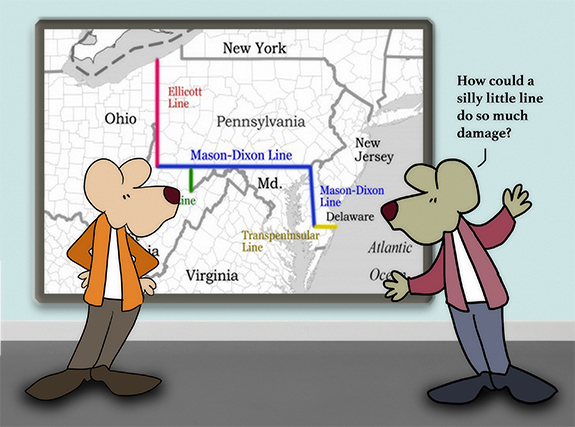There are times in our lives when one little thing we do, one little action, has a significant and lasting impact on the rest of our lives.
Oh. I don’t know. It could be anything. Take Berty McIntry, for example. She played Canasta with friends every Saturday morning in the basement of St. Thomas’s Church. Well, they had a pipe burst one Saturday morning, and Canasta was canceled. On her way home, she decided to stop at a garage sale she had passed on the way there. While milling around, she saw an old ugly painting for sale. She hated the painting but loved the frame. She found out five months later it was a lost work of Vincent Van Gogh, and it sold at auction for $2.8 million dollars.
Those kinds of things. Sometimes the happenstance is good. Sometimes it is bad.
Well. Such was the case, I think, on this date, October 18, 1767.
That is when two guys, Charles Mason and Jeremiah Dixon, completed their survey of the boundary between the colonies of Pennsylvania and Maryland, as well as areas that would eventually become the states of Delaware and West Virginia.
You see, there were two families. The Penns and Calverts. They had been having a nasty dispute over the boundary between their two proprietary colonies, Pennsylvania and Maryland. So those families hired Mason and Dixon, English surveyors, to settle their quarreling.
Yes. There it was. The Mason-Dixon Line was born. Many U.S. citizens probably don’t know where it is located, but the Mason-Dixon Line holds a significant place in American history. It stretches across approximately 233 miles. This boundary of separation represents the border between four U.S. states: Maryland, Delaware, Pennsylvania, and West Virginia. And, this silly old line has played a crucial role in shaping the nation’s cultural, social, and political landscape.
The significance of this border goes well beyond resolving land disputes.
The Mason-Dixon Line soon became a symbol of the division between the North and the South, ultimately playing a role in the American Civil War. In those late 1700s, people started drawing up their sides, too. So the line ended up separating the slave states of the South from the free states of the North. In addition, it represented the stark contrast in beliefs, in values, and in the economic systems that fueled the conflict.
While initially intended as a simple geographic marker, it became a metaphorical line in the sand.
Over the years, several misconceptions and controversies have surrounded the Mason-Dixon Line. One common misconception is that the line represents the divide between the North and the South in its entirety. But. In reality, the line only separates a portion of the states along its path.
But the main thing is the representation of the separation. This can still be felt strongly today.
The very creation of that line set the foundation for the cultural and ideological divisions that continue to run deep.
There are people in this world who believe in equal rights for all people.
And then there are multitudes of people who think they are superior to others. Men over women. Whites over blacks, Hispanics, and on. Christians over Muslims. They believe their place on this Earth is shrouded with supremacy. They continue to draw those lines.
I’d like to live in a world where people were building more bridges and larger tables. I’d like a place where the fences were being torn down. A world where the lines were being rubbed out, never to be seen again.
“”””””””””””””””
There are two kinds of pride, both good and bad. ‘Good pride’ represents our dignity and self-respect. ‘Bad pride’ is the deadly sin of superiority that reeks of conceit and arrogance.
— John C. Maxwell
“”””””””””””””””
Intolerance is the most socially acceptable form of egotism, for it permits us to assume superiority without personal boasting.
— Sydney J. Harris
“”””””””””””””””
Lord, make me an instrument of thy peace. Where there is hatred, let me sow love.
— Francis of Assisi
“”””””””””””””””
The line, they line. The drew the line.
